Kimchi is one of those things that seems so exotic but is so ridiculously easy to make at home — and fresh, homemade kimchi is infinitely better tasting than anything you can buy from the market.
If you’ve never had this fermented side dish, think of it like a spicy Korean version of sauerkraut. The smoke and fire comes from gochugaru, a Korean red pepper powder (sometimes also called Korean chile flakes or Korean chili powder, but definitely not to be confused with American red pepper flakes or American chili powder).
Homemade kimchi is a pungent and complex blend of flavors owing to traditional spices (gochugaru, garlic and ginger) as well as a puree of Asian pear and yellow onion, which adds a subtle sweetness without the need for sugar. I use red cabbage for the same antioxidant benefits I get from my ruby kraut. (But you can also use the more traditional napa cabbage.)
Similar to kraut, kimchi is full of probiotic goodness and it’s not solely limited to Korean dishes. I’ve made kimchi omelets, kimchi quesadillas, kimchi pizza, and even spooned a heaping of kimchi on a baked potato. This version is a medium spicy that won’t burn your tongue off, but still has enough heat and tang to make a meal interesting.
Red Cabbage Kimchi
Makes 3 quarts
Ingredients
2 pounds red cabbage, chopped
1/4 cup pickling salt
1/2 pound daikon, julienned
1/2 pound carrot, julienned
6 green onions, sliced into 1-inch segments
4 cloves garlic, minced
1-inch piece fresh ginger, peeled and minced
1 small Asian pear (or apple), peeled, cored and chopped
1 small yellow onion, chopped
1 cup dechlorinated water
1/2 cup gochugaru (Korean red pepper powder)
2 tablespoons fish sauce
Making Your Red Cabbage Kimchi
Red cabbage tends to be a tad tougher than napa cabbage, so I chop mine into thin, bite-sized pieces.
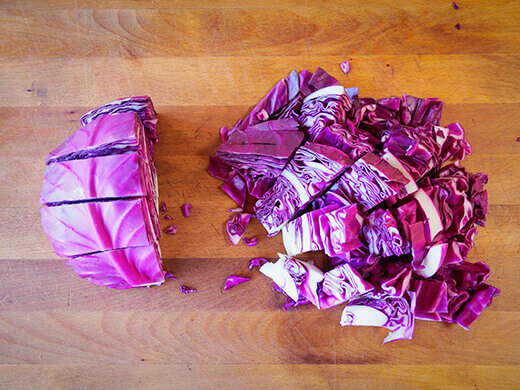
In a very large bowl, massage the salt into the cabbage until the leaves start to release liquid.
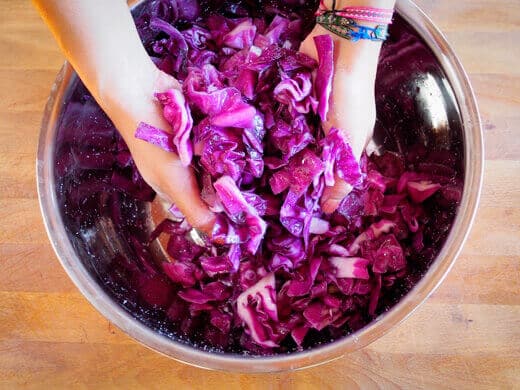
Cover with water and let the cabbage sit at room temperature for at least two hours while the salt draws out moisture. Periodically toss the cabbage and work your hands through the leaves to expel more moisture.
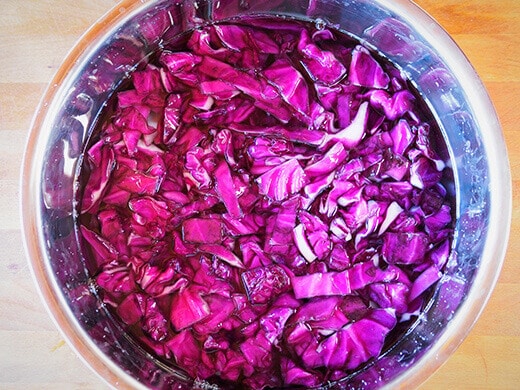
After about two hours, the cabbage should be soft and limp, and the volume reduced in half. (If yours is still firm and full, come back to it after another hour or two.)
Strain the cabbage and rinse under running water to remove excess salt.
Strain again, then return the cabbage to the bowl. Add daikon, carrot, green onions, garlic, and ginger.
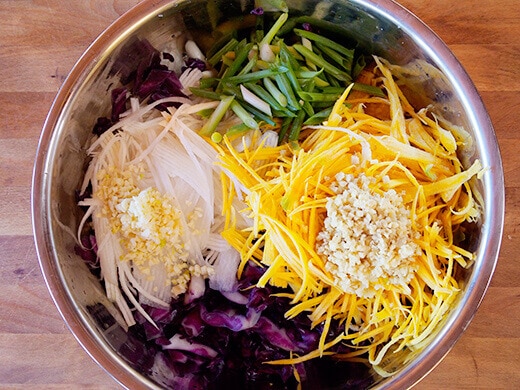
In a blender, combine the Asian pear (or apple, if using), yellow onion, water, gochugaru, and fish sauce, and give everything a whirl until smooth. Pour the sauce over the vegetables.
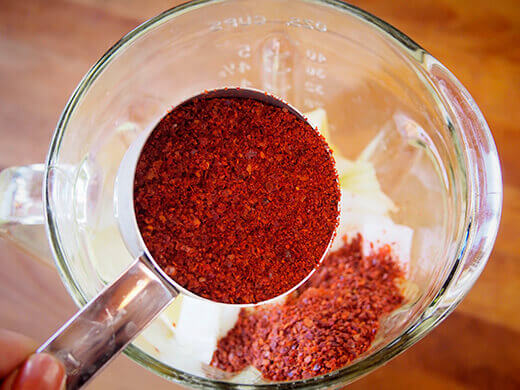
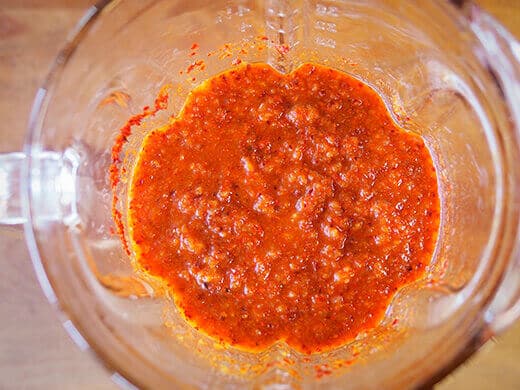
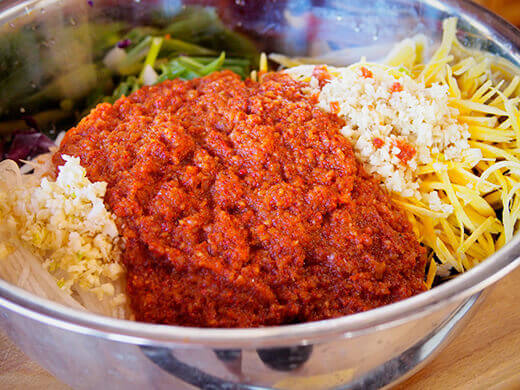
Now, don some gloves (the sauce can be pretty spicy and smelly to work with!) and give the kimchi a good rubdown, making sure the veggies are well combined and coated with sauce.

Pack the kimchi into jars, leaving 1 to 2 inches of headspace. The veggies will expand and release more liquid as they ferment, so you don’t want to overfill the jars.
Tamp down the veggies with the back of a spoon to fully submerge them. I find that there’s always enough liquid in the jars to keep them submerged, and since the liquid is more of a paste, the veggies don’t float to the top as in other ferments.
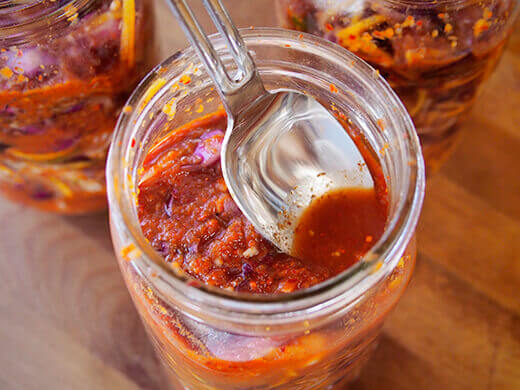
Wipe the rims clean, then loosely seal with lids and let the jars ferment at room temperature, out of direct sunlight, for at least three days. (It wouldn’t be a bad idea to place the jars in a shallow baking dish to catch any overflow of liquid.)
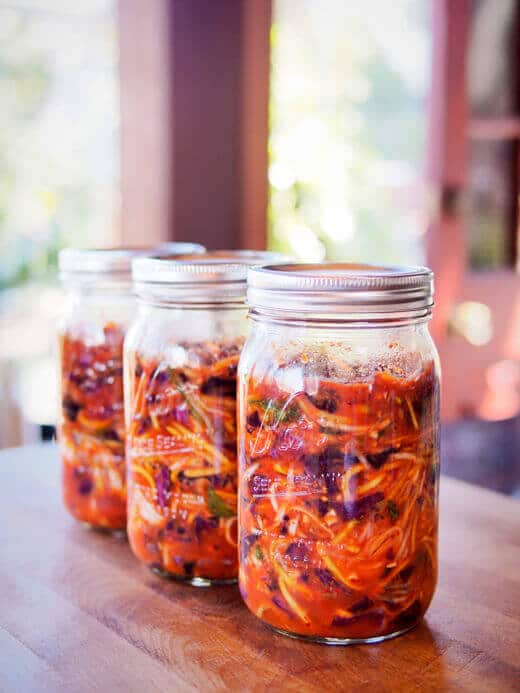
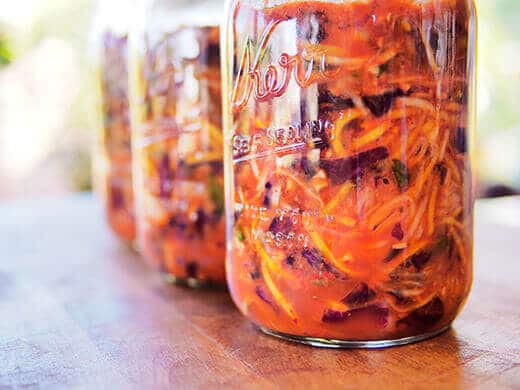
Every day, press down on the veggies with a spoon to expel more liquid and make sure everything is shipshape. A proper ferment should have no mold and no off smell.
After three days, you can start tasting the kimchi; refrigerate when the flavor has fermented to your liking. It should take on a spicy, sour taste. Some people like less sour and some like more sour, but you should definitely wait for your kimchi to take on a noticeably tangy taste if you want all the beneficial Lactobacilli in your ferment. I like to let mine brew for up to a week at room temperature for a more intense flavor.
Don’t worry if you feel that 3 quarts is too much kimchi for you to handle — let one of the jars get too sour in the fridge, and next month I’ll share one of my favorite Korean comfort food recipes that uses overly fermented kimchi!
Red Cabbage Kimchi
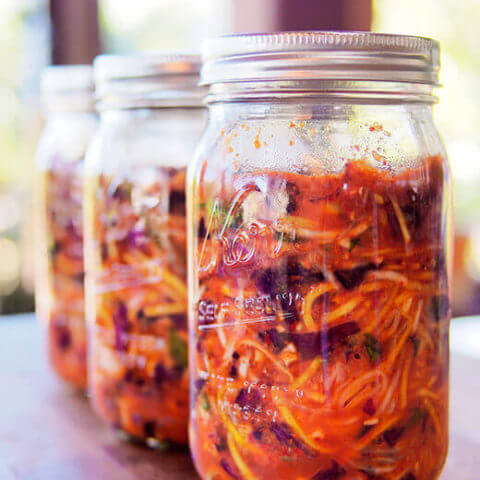
Homemade kimchi is a pungent and complex blend of flavors owing to traditional spices (gochugaru, garlic and ginger) as well as a puree of Asian pear and yellow onion, which adds a subtle sweetness without the need for sugar.
Ingredients
- 2 pounds red cabbage, chopped
- 1/4 cup pickling salt
- 1/2 pound daikon, julienned
- 1/2 pound carrot, julienned
- 6 green onions, sliced into 1-inch segments
- 4 cloves garlic, minced
- 1-inch piece fresh ginger, peeled and minced
- 1 small Asian pear (or apple), peeled, cored and chopped
- 1 small yellow onion, chopped
- 1 cup dechlorinated water
- 1/2 cup gochugaru (Korean red pepper powder)
- 2 tablespoons fish sauce
Instructions
- Chop Cabbage
In a very large bowl, massage the salt into the cabbage until the leaves start to release liquid.
Cover with water and let the cabbage sit at room temperature for at least two hours while the salt draws out moisture.
Periodically toss the cabbage and work your hands through the leaves to expel more moisture.
After about two hours, the cabbage should be soft and limp, and the volume reduced in half. (If yours is still firm and full, come back to it after another hour or two.)
Strain the cabbage and rinse under running water to remove excess salt.
Strain again, then return the cabbage to the bowl. Add daikon, carrot, green onions, garlic, and ginger.
In a blender, combine the Asian pear (or apple, if using), yellow onion, water, gochugaru, and fish sauce, and give everything a whirl until smooth. Pour the sauce over the vegetables.
Now, don some gloves (the sauce can be pretty spicy and smelly to work with!) and give the kimchi a good rubdown, making sure the veggies are well combined and coated with sauce.
Pack the kimchi into jars, leaving 1 to 2 inches of headspace. The veggies will expand and release more liquid as they ferment, so you don’t want to overfill the jars.
Tamp down the veggies with the back of a spoon to fully submerge them. I find that there’s always enough liquid in the jars to keep them submerged, and since the liquid is more of a paste, the veggies don’t float to the top as in other ferments.
Wipe the rims clean, then loosely seal with lids and let the jars ferment at room temperature, out of direct sunlight, for at least three days. (It wouldn’t be a bad idea to place the jars in a shallow baking dish to catch any overflow of liquid.)
Every day, press down on the veggies with a spoon to expel more liquid and make sure everything is shipshape. A proper ferment should have no mold and no off smell.
After three days, you can start tasting the kimchi; refrigerate when the flavor has fermented to your liking. It should take on a spicy, sour taste
Notes
Red cabbage tends to be a tad tougher than napa cabbage, so I chop mine into thin, bite-sized pieces. Don’t worry if you feel that 3 quarts is too much kimchi for you to handle — let one of the jars get too sour in the fridge.
Recommended Products
As an Amazon Associate and member of other affiliate programs, I earn from qualifying purchases.
-
 Ball Mason 32 oz Wide Mouth Jars with Lids and Bands, Set of 12 Jars.
Ball Mason 32 oz Wide Mouth Jars with Lids and Bands, Set of 12 Jars. -
 Organic Bamboo Cutting Board Set of 3 with Lifetime Replacements - Wood Cutting Board Set with Juice Groove - Wooden Chopping board Set for Kitchen, Meat and Cheese - Wooden Cutting Boards for Kitchen
Organic Bamboo Cutting Board Set of 3 with Lifetime Replacements - Wood Cutting Board Set with Juice Groove - Wooden Chopping board Set for Kitchen, Meat and Cheese - Wooden Cutting Boards for Kitchen -
 ZWILLING Pro 7-inch Rocking Santoku Knife, 7'', Black/Stainless Steel
ZWILLING Pro 7-inch Rocking Santoku Knife, 7'', Black/Stainless Steel
View the Web Story on red cabbage kimchi recipe.


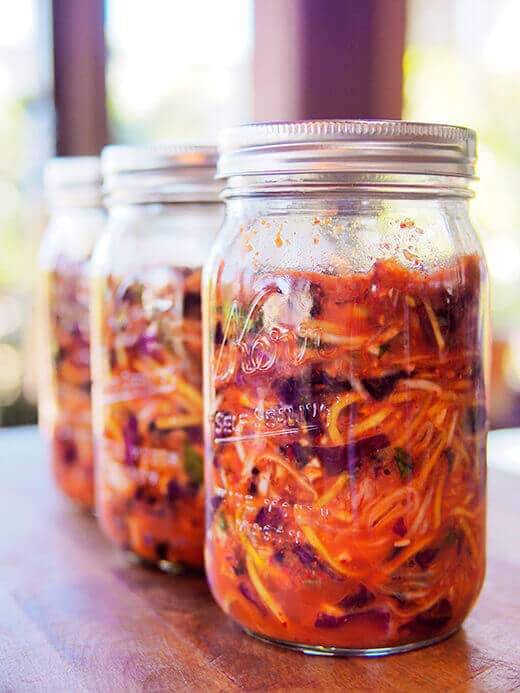













I have just made my first Kimchi. It has been sitting in a dark pantry for 2 weeks. Just pulled it out and the top quarter is purple, while the remaining 3/4 is pink. Is this safe to eat??
It just sounds like an uneven distribution of pigments from the red cabbage. As long as there isn’t black mold on the surface (and the kimchi doesn’t smell rotten) it’s safe to eat.
Thank you Linda, I don’t have any mold at all. I had a tiny taste and it still tastes very vinegary. So I have put it back to ferment longer. Hope it works!!
Love this…here I was in my kitchen, contemplating making this, and I think, wait, the Internet has already done this….and here it is, in great detail and looking good. Thanks!
LOL thank you… it’s amazing how the Internet always seems to be on the same wavelength as you. 😉
Hooray! A recipe for Kimchi with red cabbage. I was going to make a Napa Cabbage Kimchi and some red cabbage sauerkraut (spanning the globe here…) but after taking off all the bad leaves, my Napa was TINY! So now I’m using a little napa and the rest red… thanks for sharing your recipe and beautiful photos!
You’re welcome, and enjoy your dual-cabbage kimchi. 🙂 (If you haven’t seen my recipe for red cabbage sauerkraut yet, I made it here: http://gardenbetty.com/2013/06/ruby-kraut-and-why-its-so-good-for-you/ )
I live in Culver City, where can I find good quality gochugaru? In Koreatown? Do you have a recommendation for a specific market? Also will the flavor be affected too much if I omit the fish sauce?
Thanks!
Sorry didn’t see the question below about the fish sauce ignore that part haha. Thanks again.
I’m not familiar with markets in that area, but you can easily Yelp a Korean market nearby. Gochugaru is a very common ingredient so you’ll be able to find it in any Korean market, typically sold in plastic bags in the spice aisle.
Hmm… decided to try this recipe out. I misread the instructions and used a 4-5lb cabbage. I also just used tap water since I don’t have de-chlorinated. I at least let the tap water sit for a little while. Is my kimchi possibly ruined?
The tap water should be fine. But if you used 5 lbs of cabbage and kept the same amount of spice ingredients, the kimchi probably won’t be flavorful enough, even after it’s fermented. You can mix in the extra spices now, or just wait and see how it actually tastes.
If you leave out the fish sauce will it greatly affect the taste?
If you’re familiar with how kimchi should taste, the fish sauce does make a noticeable difference.
Blue Strong liked this on Facebook.
Beautifull and exellent. Thank for sharing
RT @theGardenBetty: Spicy and sour and not just for Asian dishes. Red Cabbage Kimchi http://t.co/EnPLC8I7GS #fermentation #recipe < TY for …
Spicy and sour and not just for Asian dishes. Red Cabbage Kimchi http://t.co/EnPLC8I7GS #fermentation #recipe < TY for RT! @spadeandseeds
RT @theGardenBetty: Spicy and sour and not just for Asian dishes. Red Cabbage Kimchi http://t.co/EnPLC8I7GS #fermentation #recipe < TY for …
RT @theGardenBetty: Spicy and sour and not just for Asian dishes. Red Cabbage Kimchi http://t.co/EnPLC8I7GS #fermentation #recipe < TY for …
Spicy and sour and not just for Asian dishes. Red Cabbage Kimchi http://t.co/EnPLC8I7GS #fermentation #recipe < TY for RT! @BillNigh
All the Lactobacilli and antioxidants that are good for your gut. Red Cabbage Kimchi http://t.co/FzOEvWyfv2 #korean #ferment #recipe
RT @theGardenBetty: A hot and tangy ferment that’s so easy to make at home. Red Cabbage Kimchi http://t.co/8QfAYbOzce #korean #preserving #…
A hot and tangy ferment that’s so easy to make at home. Red Cabbage Kimchi http://t.co/8QfAYbOzce #korean #preserving #recipe
A complex and pungent blend of flavors in this lacto-fermented food. Red Cabbage Kimchi http://t.co/80H05pMPXG #preserving #recipe
Maureen Hope Wall liked this on Facebook.
Oh yum yum yum! I love Kimchee 🙂 Though not for all three meals (including breakfast) like the Koreans do it.
Reading that cloves were in your recipe was a surprise…is that your own invention? Sounds interesting!
Cloves of garlic, not clove buds. 🙂
Haha 🙂
RT @theGardenBetty: Spicy and sour and not just for Asian dishes. Red Cabbage Kimchi http://t.co/EnPLC8I7GS #fermentation #recipe
Spicy and sour and not just for Asian dishes. Red Cabbage Kimchi http://t.co/EnPLC8I7GS #fermentation #recipe
Amy Goo liked this on Facebook.
Homemade kimchi is infinitely better tasting than anything you can buy from the market. Red Cabbage Kimchi http://t.co/XjuWk6I7Qy #recipe
Esther Van de Klundert liked this on Facebook.
Kim Routh liked this on Facebook.
Looks beautiful! I’ve been thinking about making kimchi for a while. There’s a napa cabbage in my fridge right now, just waiting for the opportunity to be transformed and then delivered to my mouth on some fish tacos. I’ve been digging fermentation lately; I started a nukadoko, which makes delicious pickles!
Ohhh interesting! I’ve heard of nukadoko but never attempted it myself because of the constant monitoring it requires. But I’m intrigued!
Yeah, it requires some watching, and some time to come up to speed. I was kind of worried about the investment required – what if the pickles were super funky tasting? I mean, come on, it’s fermented rice bran and seaweed. But the pickles are totally ordinary, light-tasting and fresh. And definitely “fast food” in terms of pickling, needing only a few hours for small, thin veggies and overnight for larger ones. They’re a bit soft (no pickle crisp in the recipe, haha) but quite good.
Babsi Schneider liked this on Facebook.
Making Kimchi has been on my short list for a while. I am totally jazzed to have such great instructions!
It’s so easy that it might even become part of your standard kitchen rotation! Have fun!
Kitchen Garden Maui liked this on Facebook.
Awesome! I’m a kimchi lover but I’ve never tried to make kimchi with red cabbage – this looks so ono I have to try it!!
You can try other brassicas too, like bok choy or mustard. In fact, you can kimchi pretty much any vegetable like green onions, radishes, and cucumbers (all favorites of mine).
Michael Q. Serdenia liked this on Facebook.
Deborah Fedorchak Liberatore liked this on Facebook.
Michael Fedorchak liked this on Facebook.
David Stupplebeen liked this on Facebook.
Tracy Adams Doiron liked this on Facebook.
Thanks for posting this! I’ve been wanting to find a Kimchi recipe – now I just have to find some of that gochugaru. :-).
RT @BG_garden: Red Cabbage Kimchi:
Kimchi is one of those things that seems so exotic but is so ridiculously easy to make at… http://t.c…
RT @BG_garden: Red Cabbage Kimchi:
Kimchi is one of those things that seems so exotic but is so ridiculously easy to make at… http://t.c…
Red Cabbage Kimchi:
Kimchi is one of those things that seems so exotic but is so ridiculously easy to make at… http://t.co/VruqfCM6Wu
Blogged on Garden Betty: Red Cabbage Kimchi http://t.co/2zCeOB2XN0